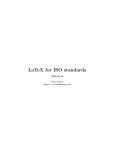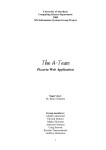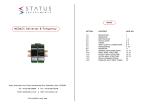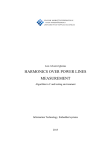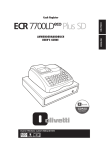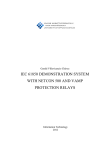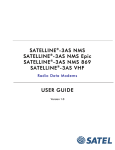Download VAASAN AMMATTIKORKEAKOULU
Transcript
Ibrahim Afolabi CONSIDERATION OF USING 3G CELLULAR NETWORK TO MONITOR ABB’S REMOTE CIRCUIT BREAKERS Technology and Communications 2012 UNIFASITY ILEIWE GIGA TI ILU VAASA Eko Imo Ero Ayara bi Asa AKORI ORO Onkowe Akole Odun Ede Ojuewe Oruko Alabojuto Ibrahim Afolabi Igbeyewo lilo 3J lati fi se isakoso awon ero tin da ina duro titi ABB 2012 Yoruba Aarun din logorin Chao Gao Alekun ninu ibeere fun agbara fun elo ile ati ileise to n sheda nkan ti se okunfaa to yara kankan to si je ogbogba ninu imuwa agbara itan ina ni ode oni. lati le dojuko opo elo ati ibeere to n be fun itan ina yii, eka to peye ati ifikun itan ina yii gbodo wa nile lati ibujoko to n mu agbara itan ina lo si odo awon ti yoo lo keyin ni ile, ibi ishe, ati awon ile ishe ton sheda nkan. Asheyori ishe yii lai fi alafia ati ibolowo ewu sere je ohun ti o doju ija ko awon oludasile agbara itan ina. Bere lori eto eka itan ina, titide bibojuto ati idari awon ibujoko itan ina oniranran pelu awon ogba imu ina wa kereje kereje, kii se ise kekere rara. Atagba ifisu/otelemuye ti oyato si kilofolt, pelu awon okun ina alagbara to se regi, nla ati kukuru je ohun ti o doju ija koni. Lati ara beelo, lilo ona omiran lati se atagba awe-oro jeyo. paapa julo siso oro lai lo okun tin gbe ohun ranshe ninu afefe. Ona abayo akoko ti ABB lo ni Radio frequency modem. Eyi kii le gbo isoro idijulolu awon eka itan ina. leyin naa ni atun se afihan awon Modeemu ero telifoonu agbeka ti amo si GSM,amo won ko pe rara nitori won maa n dakudaji. lati le bori isoro yii, ise afihan ero GPRS modem waye ni odun edeegbewa le meta. Nibayi, mo n se afihan 3G modem fun ABB, ati awon anfaani ti orogbayiika pelu idojuko pataki si asiko idaduro ajo rogodo ati ipadanu eru. Lati se agbeyewo pataki awon ohun mejeeji yii, ani lati se progiramu eyi ti alefi koko gbiyanju isisee re wo na, nibi isoro ngbesi tin lo 3G modem, ase iyannana awon esi ti ari latara igbeyewo ti afi progiramu na se, asi ri wipe o mo ni iwonba legbe awon tekinologi ateyinwa, paapa julo Radio frequency modem. Nigbeyin, alefi gbogbo enu so wipe fifi 3G modem ropo tekinologi ateyinwa fun ise amojuto eka itanna yio je ohun ti koni mu ewu wa rara. Koko inu oro aifojuri ranse, ABB ibolowo ewu, RF modeemu, GSM, GPRS, 3G, Ifi ohun VAASAN AMMATTIKORKEAKOULU UNIVERSITY OF APPLIED SCIENCES Degree Program of Information Technology ABSTRACT Author Title Ibrahim Afolabi Consideration of using 3G cellular network to monitor ABB’s remote circuit breakers Year 2012 Language English Pages 75 Name of Supervisor Chao Gao Increase in the energy demand for domestic purposes as well as in the manufacturing industries has led to a rapid and proportional increase in the electrical energy production today. In meeting this huge electric consumption and demand, proper network and supply of electric power has to be in place from the electric energy generation stations to the final user i.e. the consumers at home, in offices and heavy manufacturing industries. Achieving this goal without mincing safety and security, pose a great challenge to the energy producers. From the proper planning of electrical networks to the meticulous and adequate monitoring and control of various electrical substations and power outlets this is in no way an easy task. Transmission of intelligent information other than kilovolts via normal high and low tension cables posed a great difficulty. Hence, the need to use another means of data communication, precisely wireless communication. The first solution as used by ABB was a radio frequency modem which turned out not to be able to properly handle the complexity of some electrical networks. Then, GSM modems were introduced but did not last for too long because they suffer from periodic re-establishment of connection and to solve this problem, GPRS modems were introduced in 2003. And now am introducing 3G modems to ABB with its numerous benefits and a major focus on the influence of the round trip delay time and packet loss. To research the significance of this two factors, an emulation program was designed to send and receive data over a 3G modem, data samples were taken and analyzed and it was discovered that the factors considered are significantly minimal when compared to the rest of the previous technologies especially the radio frequency modem. And it can be safely concluded that the 3G modem can be used to replace any of the previous technologies for the purpose of monitoring the electrical power distribution network. Keywords Safety, RF modems, GSM, GPRS, 3G, Transmission, ABB ACKNOWLEDGEMENT To Allah azza wajal (God the Almighty) who made me who I am today and will make me what I hope to become tomorrow. To my mother who instilled in me the “never say die” spirit and is everything to me. She taught me to give and never look back, share and never expect, she is an exemplary giver, to whom this final thesis is dedicated. To my father, a man of honour and integrity the best one can have. He taught me discipline, diligence, fairness, patience, modesty, humility and respect for others and their rights. To my siblings, who have been supportive of my decisions in life and have always being there for me. To friends, my brothers and sisters from another mother, who have been a source of motivation and have inspired me enormously. To Gao Chao (Dr.), my supervisor, an esteemed instructor of high standards, a teacher of quality and ethics, a man of dignity and respect someone I owe a lot to for his tremendous support in the cause of this thesis and my study at VAMK. To Liu Yang (Dr.), the challenger, who would squeeze the best out of you. To Johan Dams, the greatest motivator have ever met, makes the most difficult seem so simple. To Makelä Jarmo (Dr. Principal lecturer), the most humble and sound minded mathematician and physicist have had the honour of studying under. I personally refer to him as Mr. Mathematics made easy. To Seppo Makkinen (Dr. Principal lecturer), easily approachable, someone who can take you on a trip to the land of the greatest physicists and you will never be bored. He is a man of practicality and precision. And to a whole lots of other teaching members of staff at VAMK. To my doctor, though you came later but your impact was immeasurable and to everyone who has been a part of my story both in the past and at present. I appreciate you all and love you so much, thank you. Ibrahim Adewale Afolabi. 5 CONTENTS AKORI ORO ABSTRACT ACKNOWLEDGEMENT ...................................................................................... 4 ABBREVIATIONS................................................................................................. 9 1 INTRODUCTION .......................................................................................... 10 1.1 Thesis Outline ......................................................................................... 10 2 ELECTRICAL POWER DISTRIBUTION NETWORK ............................... 11 2.1 Description of Each Power Grid ............................................................. 14 2.1.1 Power Substation......................................................................... 14 2.1.2 Recloser or Auto-Recloser .......................................................... 15 2.1.3 Disconnector ............................................................................... 16 2.1.4 Distribution Transformer ............................................................ 17 2.1.5 Ring Main Unit (RMU) ............................................................... 19 3 AVAILABLE WIRELESS TECHNOLOGIES FOR REMOTE CONTROL IN ELECTRICAL NETWORKS .......................................................................... 21 3.1 GSM Technology Overview ................................................................... 22 3.2 GPRS Technology Overview .................................................................. 23 3.3 3G Technology Overview ....................................................................... 23 3.4 Normal Radio Modem ............................................................................ 24 4 RADIO FREQUENCY MODEM .................................................................. 26 4.1 Satelline Radio Modem........................................................................... 26 4.1.1 Satelline 3AS(d) Technical Specifications.................................. 27 4.1.2 Configuration and Installation..................................................... 29 4.1.3 Interfaces and Connectors ........................................................... 30 4.1.4 RS-232 Interface ......................................................................... 31 4.2 RF Interface ............................................................................................ 31 4.2.1 Transmitter .................................................................................. 32 4.2.2 Receiver....................................................................................... 32 4.2.3 Priority RX/TX............................................................................ 32 4.3 Transparent Data Transmission .............................................................. 33 4.3.1 Serial interface and data format .................................................. 33 4.3.2 Handshake lines .......................................................................... 35 4.3.3 Possible delays and timing during data transmission .................. 35 4.4 Repeater Mode and Addressing .............................................................. 38 4.4.1 Repeater....................................................................................... 38 4.4.2 Addressing................................................................................... 39 4.4.3 Repeaters and addresses operating in the same system .............. 39 4.5 Message Routing ..................................................................................... 40 4.5.1 Message Routing features ........................................................... 42 4.5.2 Message Routing Limitations ..................................................... 42 4.5.3 Message Routing planning .......................................................... 43 4.5.4 SaTerm and Message Routing configuration .............................. 43 4.5.5 Manual Configuration ................................................................. 44 4.5.6 Operating modes of Message Routing ........................................ 44 4.5.7 Network ID.................................................................................. 46 5 TESTS, RESULTS AND ANALYSIS ........................................................... 47 5.1 Satelline-3AS Radio Modem .................................................................. 47 5.1.1 System Setup ............................................................................... 47 5.1.2 Test arrangements ....................................................................... 48 5.1.3 Laboratory Tests Results ............................................................. 48 5.1.4 Result Analysis............................................................................ 51 5.2 3G Based Technology ............................................................................. 54 5.2.1 System Setup ............................................................................... 55 5.2.2 Test arrangements ....................................................................... 56 5.2.3 Test Results ................................................................................. 57 5.2.4 Result Analysis............................................................................ 59 6 CONCLUSIONS AND RECOMMENDATIONS ......................................... 65 7 REFERENCES ............................................................................................... 67 7 LIST OF FIGURES AND TABLES Figure 1. Power distribution network from Power generation to Metering 12 Figure 2. Technical description of electrical power network wireless monitoring 13 Figure 3. Hydroelectric power substation. 15 Figure 4. Pole mounted Recloser 16 Figure 5. An old pole mounted Disconnector 17 Figure 6. A pole mounted Distribution Transformer. 18 Figure 7. Satelline-3AS radio modem 26 Figure 8. SATELLINE-3AS message routing network structure 41 Figure 9. TX data signal capture 49 Figure 10. Data packet transmission delay zoomed in 49 Figure 11. TX and RX data signal capture 50 Figure 12. TX/RX Poll and Reply sequence 50 Figure 13. Transmitted request data format 51 Figure 14. Client/Server emulation program output beginning 58 Figure 15. client/server emulation output and average RTT 59 Figure 16. Packets sent against Packets Loss 61 Figure 17. Average RTT against Packets Loss 61 Figure 18. RTT distribution with respect to frequency 62 Table 1. Technical specifications of SATELLINE-3AS radio modem /11/ 29 Table 2. Installation settings and configuration /12/ 30 Table 3. Data format example. 34 Table 4. Handshake lines /27/ 35 Table 5. SATTELINE-3AS message routing operating modes 45 Table 6. Packets sent, received and loss with average RTT 61 9 ABBREVIATIONS RMU Ring Main Unit SCADA Supervisory Control And Data Acquisition IEC International Electrotechnical Commission UDP User Datagram Protocol HSPA High Speed Packet Access RTT Round Trip Time GPRS General Packet Radio Service GSM Global System for Mobile Communication 3G 3rd Generation TDMA Time Division Multiple Access UMTS Universal Mobile Telecommunication System PRN Private Radio Network CDMA Code Division Multiple Access VPN Virtual Private Network EMC Electromagnetic Compatibility TETRA Terrestrial Trunked Radio EDGE Enhanced Data rate for GSM Evolution 1 INTRODUCTION The world of today is called a global village and that is because what could not have been done within months if not years some decades back are accomplished within few seconds. Data is readily available to be processed into information and then to be used for different purposes. These pieces of information are gathered through media such as air (wireless) and cable (wired) and then processed into complete and meaningful information. In this project, the aim is to take a brief look into how data other than just voltages of electricity are sent to and received from power base stations and research into the possibility of using 3G technology in a bid to monitor and control power transmission networks from the power stations until it gets to the final consumers. We are coming from an era of electrical power distribution, where minimal attention is paid to efficient distribution of power, safety of life and property after installations especially in times of emergencies which could arise from any man made or natural disaster, inefficient management and detection of power outages, improper planning of electrical power network and distribution etc. 1.1 Thesis Outline To successfully discuss the objectives of this thesis as mentioned in the last sentence of paragraph one, the following has to be looked into in subsequent chapters: - modern day power distribution networks - wireless technologies available and in use for remote control and monitoring of electrical power distributions - general introduction of the radio frequency modem - tests and analysis of results and - conclusions and possible recommendations suggested. 11 2 ELECTRICAL POWER DISTRIBUTION NETWORK In the past few decades, safety and security of life is no longer a thing of option instead it has been made strictly part of every decision made during the implementation phase of most if not all projects that has to do with electric power and installations. Especially, in most developed world and this same system is gradually and rapidly spreading across the developing worlds. In fact, in a way to standardize this new practice, standard bodies are being put in place to make sure all the rules and protocols to ensuring that all stipulated standards are followed to the latter. A diagrammatic representation of this modern system and method of electrical power networks and distribution is shown in Figures 1 and 2 below, first is a figure that shows a literal image of such network distribution and then second a more technical figure. The images are the Viola system’s comprehensive range of devices for automating and monitoring various elements found in different stages of electrical power distribution networks and smart grid technology implementation. /1/ Figure 1. Power distribution network from Power generation to Metering. /1/ 13 Figure 2. Technical description of electrical power network wireless monitoring. /2/ The Figures above depicts what a typical modern day electrical power distribution network looks or should look like. Where wireless communication network are made an intrinsic part of the electrical network planning and configuration and implementation phase. Each part of the power distribution section having its own appropriate wireless communication and data transmission device. Starting from the Substation to the Recloser to the Disconnector and then to the Metering part of the entire distribution network. 2.1 2.1.1 Description of Each Power Grid Power Substation This is a fundamental part of electric power generation, transmission and distribution system. It usually marks the beginning of electric power distribution. It is made up of units that perform very important roles in power distribution and transmission. Substations have very powerful transformers that transform voltage from low to high or high to low depending on the requirement at that particular station. When power generation starts from the main generating plant, it usually flows through more than one substation before finally reaching the final consumers, with its voltage going through series of step ups and step downs via the use of step up and step down transformers respectively. Modern day substations are usually unattended to except in some really critical situations, they are built in such a way that remote control and supervision can be done via an industrial control system called SCADA (Supervisory Control And Data Acquisition) running on computers in a control center or centers. Substations consist of components such as power transformers, switching, and protection gear and control equipments. A large station usually has circuit breakers used to interrupt the power network in case of a fault which may result to short circuits or current overload. Devices such as sophisticated capacitors and voltage regulators can also be found at a power substation. 15 Figure 3. Hydroelectric power substation. /7/ 2.1.2 Recloser or Auto-Recloser In electric power distribution system, a Recloser also known as auto-Recloser is a momentary circuit breaker which has a mechanism that can automatically close a circuit breaker after it has been opened due to a fault. Recloser are installed on overhead power distribution systems to detect and interrupt faults, and then restore power to the distribution line after the momentary fault has been fixed. In a bid to improve power distribution quality and enhance safety of life and power equipments, substations along a distribution network are protected with installed circuit breakers or fuses which are capable of turning off power in the event of fault detection such as short circuit. Basically, Reclosers are located at intervals in network where it is possible to divide the electric power network into smaller sections or grids in a way that it will be possible to utilize less power to trip off only the section it is responsible for in events of fault detection. Figure 4. Pole mounted Recloser /8/ 2.1.3 Disconnector Disconnectors which are otherwise known as Isolators are used in electrical power distribution to ensure total disconnection or cut-off of power from electrical power circuit in a situation of fault fixing and maintenance purpose. In situations where there is need for adjustment or repair of apparatus such as circuit breakers and transformers and transmission lines, high voltage Isolator switches usually comes in handy which enable a total isolation of the remaining distribution network. And power can be temporarily restored to the isolated area through other forms of power generation available at that particular point in time e.g. wind mill generated power. They are not aimed at providing a normal day to day control functions on the power circuit, they act basically as isolators. Disconnectors are called to use 17 whenever field maintenance is required on any of the network sites. They can be operated both manually and remotely, and for this reason, there is provision for padlocks so that when field engineers are working to fix a problem on a site after electricity has been put off, accidents resulting from inadvertent operation to restore power back to the site through remote control or an unconcerned individual engineer could be absolutely prevented and avoided. So, the Disconnector is for ensuring absolute safety on the power distribution network. Figure 5. An old pole mounted Disconnector /9/ 2.1.4 Distribution Transformer In power distribution network, a distribution transformer is a transformer that does a high to low voltage transformation of voltage. It provides power to the final consumers at a stepped down level that suits the need of the customers. They are of two main types based on where they are installed. If installed on a pole, they are referred to as a pole-mounted transformer and if they are found in- stalled on the ground level or mounted on a concrete pad in most cases locked in a steel house, and in other cases such as those found in some developing countries which are left naked on the concrete pad on the street they are known as padmounted transformers. And usually, they are made to transmit voltages below 30kV especially those mounted on the pole due to the weight restriction. Distribution transformers are normally located at distances where it is quite easy to run electric cables from electric power pole or underground power lines to a customer’s facilities. They are used for power supply to consumer’s facilities such as farmyards, pumping stations, large high rise buildings etc. where power is provided at voltages under 30kV. They could be single phase transformers, like those generally used in the USA power distribution system and could be three phase transformers, like those used in the European power system, where three secondary windings are attached to the three primary phase wires to provide power for residential services. Figure 6. A pole mounted Distribution Transformer. /9/ 19 2.1.5 Ring Main Unit (RMU) Ring main unit is a part of the electric power distribution network which is usually a standard piece of switchgear comprising of switches for switching rings of low voltage power cables and also for switches connected in series with fuses for the purpose of protecting distribution transformers from direct impact of faults on the power distribution network. It is a secondary branch of the power distribution network system. Basically, it ensures uninterrupted flow of power and protection of the secondary side distribution transformer from periodic transient currents and it limits the effects of faults on the network. It usually comes in a complete protection house made of alloys and consists of switch-disconnectors, earthing switch, fuse switch or circuit breakers and other protection units that make up a complete functional ring main unit. In Finland for example, the Reclosers and the Disconnectors are made together as one unit and are otherwise and sometimes called Isolator in the U.S.A. Moving from the Substation to the Metering, the amount of Voltages transmitted through the cables reduces from about 400kilovolts to about 400volts which finally gets to the final consumers and further stepped down to the required amount of about 240 to 230volts for basic home appliances. They all function in a well coordinated way via the functionality provided for by the MicroScada software running on a computer in a control room. They work in such a way that the respective modems running on either of the available wireless technologies as a means of communication backbone would send and receive information to and from a control room. The control room has software applications for example the ABB MicroScada pro running on computers in the control room that coordinate, monitor, control and poll information from these various and respective wireless modems wherever they may be, so far they are properly configured and are within the coverage range. The information sent and received are created, structured and formatted depending on the type of interfacing devices working on the various electrical infrastructure responsible for the various phase of electrical power distribution as in the one described in the figure 2 above. And more also depend on the IEC protocol with which it is configured and running. These interfacing devices for example, the ABB REC523 which is directly connected to the power cable transmitting the electrical power has been hard coded and configured to work on IEC 60870-5-101 protocol in a way that it has addresses for all the available electric cable carrying voltage connected to it and transmits bits of data based on the events happening on it to the control room remotely via a wireless modem for example, the Satelline radio frequency modem one of those making ways in Finland today. 21 3 AVAILABLE WIRELESS TECHNOLOGIES FOR REMOTE CONTROL IN ELECTRICAL NETWORKS Transmitting, encrypting and deciphering of data could be done using any of the suitable existing backbone technologies available today. Some of these available technologies are TETRA, GSM, GPRS, 3G, Normal radio frequency modems etc. The most commonly used and currently still in use for the purpose of transmitting intelligent safety information passing through overhead electrical power cable, be it public or private of these technologies are about three namely GSM, GPRS and Normal radio frequency, TETRA is exempted because it's no longer in use today because there are no more development support for it, be it from private or public organization though it is still in use by some government agencies in Finland e.g. the Finnish Fire Service. /4/ TETRA which stands for Terrestrial Trunked Radio and formerly known as Trans-European Trunked Radio is a professional mobile radio and a transceiver popularly called walkie talkie. It was a standard whose first version was published in 1995 by European Telecommunications Standard Institute. It is widely in use across the world and in full usage and deployment in up to about 114 countries cutting across almost all the seven know continents in the world today. TETRA as a wireless technology will not be discussed at length in this report due to the following setbacks it suffers since its development which makes it not so suitable for the purpose of this project work. TETRA is a technology which is designed to use a linear amplifier for a proper function as a radio frequency service provider technology. It was also designed to transfer data at a rate of 7.2kbps per timeslot with a throughput of 3.5kbpslot of net packet. According to the standard, the latest version is said to support up to 115.2 kbps in a 25kHz channel, but in reality, no networks with such data rate in is currently in operation today. To be investigated in this thesis work are the remaining wireless technologies mentioned above except TETRA, namely: GSM, GPRS, 3G and Normal radio frequency. These four are going to be researched as far as the resources available for this project can go and the technicalities behind them. Developed devices which are using these technologies and are already in use today, basically, for the purpose of transmitting wireless data conveyed on electrical networks for the monitoring and control of the electrical distribution system shall be intrinsically researched as well. A major device which will be focused upon is the SATELLINE radio modems (produced and manufactured by Satel Oy Finland) and then I shall also research the probability of adopting a 3G based technology system in doing similar job as the SATELLINE radio modems. To be discussed also are the backbone protocols upon which the proper functioning of the devices are built. Tests will be carried out to confirm if the devices actually functions exactly the way stipulated in the protocol's specifications documentation and conforms to it. And data samples shall be collected from tests and used to support my claims as it will be made in the conclusions of this report. 3.1 GSM Technology Overview GSM stands for Global System for Mobile communication. It is an idea which emerged from the cell-based mobile radio systems at Bell Laboratories about four decades ago. It is a digital cellular technology used for transmitting mobile voice and data services. The name GSM is a standardization group established in 1982 to create a common European mobile telephone standard. This standard is the most vastly accepted standards and is implemented globally. GSM is a second generation (2nd) technology based on circuit-switched system that divides each 200kHz channel into eight 25kHz time-slots. It operates in the 900MHz and 1.8GHz bands in Europe and the1.9GHz and 850MHz bands in the US. The GSM is a digital technology developed with the capability to carry 64kbps (bits per second) to 120kbps of data rates. It uses a narrow band TDMA technique for signal transmission. Apart from the normal voice service, GSM also provides data services including Roaming (ability to use an individual’s own phone number in another GSM network) service. This breakthrough in terms of acceptance made GSM most widely used cellular technology system having more than 70 percent of the world’s digital cellular subscribers./3/ 23 One of the reasons behind its development was to provide a spectrum efficient technology better than the previous first generation analogue telephone system. And this aim was achieved through the use of TDMA. The use of this method enabled the accommodation of more users within the available frequency band. In addition, data encryption of the digitally encoded speech was also adopted in other to enhance privacy and prevent eavesdropping./5/ 3.2 GPRS Technology Overview GPRS is a 2.5 digital generation system. It is a relatively “new service designed for Global System for Mobile Communications (GSM) networks. GSM is a digital cellular technology that is used worldwide, predominantly in Europe and Asia, with current estimates of 400 million subscribers and growing. GSM is the world’s leading standard in digital wireless communications.” /6/ GPRS is standardized by the ETSI. GPRS is a packet-based radio data mobile technology created to fit in between the 2G and 3G cellular communication technology. It is a packet oriented technology whose usage is charged based of volumes of data sent and received. Contrary to the GSM circuit switching data technology charged per minute of established connection time, irrespective of whether data transmission took place or not. 3.3 3G Technology Overview The word 3G stands for 3rd Generation. It is a common terminology otherwise used for the 3rd generation of mobile telecommunication technology. It is made up of a set of standards which are used for mobile devices and telecommunication services, including networks that adhere to the standards of the International Mobile Telecommunications-2000 (IMT-2000) engineered by the International Telecommunication Union. When talking of 3G to a lay man, it is best explained as all those application in wireless data transmission that support mobile internet access, video calls, teleconferencing, wireless voice telephony, tethering and fixed wireless internet access. For applications to operate using 3G wireless technologies, they have to be developed and function in accordance with the set system specifications of the IMT2000 based on the reliability and the data transfer speed of the entire system. This speed should be at least 200kbits or 0.2Mbits per second. However, most 3G services provide data speed higher than this minimum peak data rate. Some known 3G technologies are the UMTS system which was standardized by 3GPP. This technology is commonly used in Europe, Japan, china and other regions where GSM second generation system is widely in use today. The UMTS original release is called the W-CDMA and then followed by the TD-SCDMA and the latest release is HSPA+ which is capable of data transfer of about 28Mbits per second of downlink transfer of packet and 22Mbits per second of uplink practically. The other 3G technology is one which is common in the North America and also South Korea. Is the CDMA2000 system which was standardized in 2002 by 3GPP2. It shares infrastructure with the American IS-95 2G standard. Hence, most cell phones operating in the system are capable of functioning with the CDMA2000 and IS-95 hybrids. Its latest development is the EVDO which is capable of peak rates of about 14.7Mbits per second downlink. 3.4 Normal Radio Modem Radio frequency modems have the capability to transfer data wirelessly through a range of tens of kilometers. They are used by private organization to create Private Radio Networks (PRN). Private radio networks are used in industrial standard applications, when it comes to and has to do with real time data communication. Radio data modem can be independently operated making it possible not to totally rely on telecommunication or satellite network operators. Operating the radio modems and making them communicate happens through allotted licensed frequencies either in UHF or VHF band. These licensed frequencies are reserved for registered users in certain area in a way to avoid as much radio interference as possible from other Radio Frequency transmitters. Usually, this licensed frequency is available for free in most countries which enable easy implementation, but the same frequency can be used by other users. Radio modems are usually used by Land survey differential GPS, Automated Meter Reading (AMR), SCADA appli- 25 cations (utility distribution networks), fleet management applications, telemetry applications etc. Radio performance mostly plays a major role in making data transfer highly reliable. Radio performance is generally influenced by the height of the antenna and type, the sensitivity of the radio, how much power it can produce as output and the design and efficiency of the entire system design. 4 RADIO FREQUENCY MODEM In this part, I shall focus on the radio frequency due to the availability of a device working on its backbone protocols. This device is one of the numerous devices in use and in the fore front of wireless communication in electrical networks today in Finland. The SATELLINE-3AS radio data modem. A comparison between this device and the possibility of using a 3G based network system to achieve similar task will be made in a later chapter. 4.1 Satelline Radio Modem Figure 7. Satelline-3AS radio modem. /10/ To be investigated in this project is the Satelline 3AS(d) radio data modem. Laboratory exercise would be carried out on it to properly determine how it truly functions and test its limits. To achieve this, I shall use the one already in use in the electrical department of VAMK University of applied science present in the Technobothnia research laboratory Vaasa. But before I go further, a brief technical specification would be very helpful in the introduction to the radio modem. 27 4.1.1 Satelline 3AS(d) Technical Specifications Satelline 3AS or 3AS(d) radio modem is a wireless radio frequency modem with RS-232, RS-422 and RS-485 interfaces. Satelline 3AS(d) as the name implies is a modem with an LCD display with four push buttons and ordinary Satelline 3AS is without a these features. The device is capable of frame error correction and has repeater and free channel scanning functions. The 3AS(d) shows messages on display and both are compatible with Satelline-3AS Epic and Easy modems. The Satelline 3AS(d) complies with the following international standards and specifications. RADIO TRANSCIEVER Frequency range 330…470 MHz Tuning range ±2MHz from central frequency Channel spacing 12.5kHz / 20kHz / 25kHz Number of channels 320 / 200 / 160 (2 x 160 /100 /80) Frequency stability < ± 1.5kHz Type of emission F1D Communication mode Half Duplex RADIO TRANSMITTER Carrier Power 10mW….1W / 50ohm Carrier power stability + 2dB / - 3dB Adjacent Channel Power According to EN 300 220-1/EN 300 113-1 Spurious Radiation According to EN 300 220-1/EN 300 113-1 RADIO RECEIVER Sensitivity -115… -110dBm (BER < 10 E -3) Common Channel Rejection > -12dB Adjacent Channel Selectivity > 60 dB @ 12.5kHz, >70dB @ 25kHz Intermodulation Attenuation > 65dB Spurious Radiation < 2nW MODEM Interface RS-232 or RS-485, RS-422 Interface Connector D15, female Data Speed of Serial interface 300 – 38400bps Data Speed of Radio interface 19200 bps @ 25kHz, 9600 bps @ 12.5/20kHz Data format Asynchronous RS-232 or RS-422 or RS-485 29 GENERAL Operating Voltage +9 … +30Vdc Power (average) Consumption 1.1W(Rx), 5W (Tx), 0.05W (in standby Mode) Operating Range Temperature -25 ºC …+55 ºC, -40 ºC …+75 ºC(absolute min / max), Storage Temperature Range -40 ºC …+85 ºC Antenna Connector TNC, 50ohm, female Housing Aluminum enclosure Size H x W x D 137 x 67 x 29mm Installation Plate 130 x 63 x 1mm Weight 260g Table 1: Technical specifications of SATELLINE-3AS radio modem /11/ 4.1.2 Configuration and Installation The following default settings are found readily configured on the radio modem as at the point of shipment: FIXED SETTINGS DEFINED AT THE TIME OF SHIPPING Radio Frequency Range In accordance with Customer Order and taking into account the regulations set by the local authorities, between 330470MHz Channel Spacing 12.5, 20 or 25 kHz apart from the 869 MHz which must be 25kHz ADJUSTABLE SETTINGS Radio Settings 1W (3AS) / -112 dBm @ 25kHz or 114 dBm @ 12.5kHz Addressing RX address OFF / TX address OFF Serial Port 1 ON / 19200 / 8bit data / None / 1 stop bit for 12.5kHz the default data speed is 9600 bps Serial Port 2 OFF / 19200 / 8bit data / None / 1 stop bit for 12.5kHz the default data speed is 9600 bps Handshaking CTS Clear to send / CD RSSI-threshold / RTS Ignored Additional settings Error correction OFF / Error check OFF / Repeater OFF / SL-Commands OFF / Priority TX Routing OFF Tests OFF Message Routing OFF Serial Interface Type RS-232 or RS-422 or RS-485 Table 2: Installation settings and configuration /12/ 4.1.3 Interfaces and Connectors The Satelline radio modem is a DCE (Data Communication Equipment) which has a 15-pin D-type female connector, and includes all necessary connections needed to establish communication between the radio modems and computers acting as DTE (Data Termination Equipment). Also considered during its design are all necessary EMC (Electro Magnetic Compatibility) requirements in accordance with the standard set by the destination authorities. It is designed with two serial ports, port 1 and 2 of which only one can be used at a time for communication. Port 1 on the one hand, complies with the RS-232 31 standard while Port 2 on the other hand is designed to work as a 3-in-1 port in that it support either RS-232, RS-422 or RS-485 standards. And the type of interface it has is set based on customer’s want and can be later changed by the user from the programming mode. 4.1.4 RS-232 Interface The RS-232 is a standard that defines the method of serial data transfer between a computer and its hardware peripherals. This definition includes both the interface types and signal levels and is present in most computers and peripherals. The RS232 standard uses transmission lines, in which each single signal line level is connected to a common ground level. It is designed to suit serial data transfer especially in situations where the distance between communicating devices is less than 15meters. /14/ 4.2 RF Interface This model of Satelline used in this project i.e. the Satelline -3AS radio modem has a single TNC-type connector with a total impedance of 50 Ohms. Usually, the frequency range to which the device will be tuned is defined at the point of order and it can be changed afterwards by ±2MHz from the centre frequency. Bearing in mind that all local regulations set by destination authorities has to be considered and conformed with. The speed of the radio interface depends on the chosen radio channel spacing which could be either 19200bps or 9600bps. If a spacing of 25 kHz is chosen, a total of up to 19200 bits of data can be transferred through the channel in one second and if lower than that is chosen e.g. 12kHz, only 9600 bits can be sent through the channel and regardless of the chosen channel spacing, the data speed limit is fixed already at either 19200 or 9600 bps. What happens in a situation where the data speed of the radio interface is more than that of the serial interface is that the data in transfer would be buffered temporarily, so there would not be any data loss in any case./17/ 4.2.1 Transmitter The radio modem can be used as both a transmitter and receiver. When used as a transmitter, the output power can be varied of which the greatest allowable power would be decided by the local authorities. It is highly encouraged to set the output power of the transmitter to the lowest possible that can still allow error or interference free connections under severe conditions and this is because using a very strong signal to strength for short range connection could hamper the over operation of the entire system. 4.2.2 Receiver When used as a receiver, its sensitivity depends on the spacing of the channels on which the radio modem is operating and the mode of its error correction. The threshold of the receiver’s sensitivity determines a level just above which data transfer signal can be detected and active. 4.2.3 Priority RX/TX Part of the features offered by the SATELLINE-3AS is priority setting. This function selects the priority between reception and transmission. It is a function which can either be enabled or disabled from the Programming Mode. But the default setting is in terms of priority is transmission TX first, and then followed by reception. Priority TX as a setting means that a terminal device connected to the modem chooses the timing of the transmission. As soon as the terminal device is power on, the transmitter will be switch on instantly, if reception is the priority at that point in time, it would be stopped and changed to operate in a state of transmission. Priority RX as a setting means that a modem is in the receive mode is trying to receive data currently available and in transmission in the air. If a modem is currently transmitting data, the transmitted data will be temporarily buffered until the reception has stopped before transmitting the buffered data. /20/. 33 Apart from the features discussed above, Satelline Modems have additional features such as: Error correction, Error checking, Free channel scan, Dual channel function, Dual band function, LED indicators as well as LCD display and push buttons in the SATELLINE-3AS(d). 4.3 4.3.1 Transparent Data Transmission Serial interface and data format The SATELLINE-3AS radio modem uses an asynchronous data format to transmit data through the serial interface without using any external synchronizing signal. This is so, because relevant timing information defined in the start and stop bits transmitted before and after each data field bits which marks the end and start of data transmission. The data transfer speed of the serial interface varies from 300, 600, 1200, 2400, 4800, 9600, 19200 to 38400 bps. The length of the data field can only be any of 7, 8 or 9 bits. The use of data field length of 7 or 8 makes space for a parity bit. So, to transmit one character, we will need a start bit, the data bits (which is the binary representation of the character to be transmitted), an optional but useful parity bit and one or two stop bits, making the total length of the transmitted data bits to be 10, 11, or 12bits. When calculating the data throughput of a system, the number of start, stop and parity bits must also be considered for proper calculation to be attained. A very useful rule however, is that, to transmit one character with a data speed of 9600 bps, it will take roughly one millisecond (1ms). So for example to transmit “187” as an eight character data bits with a binary representation of “10111011” in the three possible ways described above, we will have the following results presented in the table below: DATA FORMAT CHARACTER CHARACTER LENGTH 8 bits, no parity, 1 stop bit 0101110111 10 bits 8 bits, even parity, 1 stop 01011101101 11 bits bit 8 bits, odd parity, 1 stop 01011101111 11 bits bit 8 bits, no parity, 2 stop bit 01011101111 8 bits, even parity, 2 stop 010111011011 11 bits 12 bits bit 8 bits, odd parity, 2 stop 010111011111 12 bits bit Table 3. Data format example. It should however be noted, that, if data speed settings, length of character, parity or the number of stop bits differ between the communicating radio modems and the terminals, errors are bound to set in into the transferred data. If the serial port settings of the radio modems exchanging data in the system are different, there is no problem, but the data length settings must always remain the same in all individual communicating radio modems. In clear and simple terms, the serial ports used for transmission, the speed of data transmission, the parity and number of stop bits, can be different in different parts of the same system with no risks of errors in the transmitted set of data. This is a very useful point to know, especially in systems where one part uses an RS-232 serial port and the other part uses RS422 serial port /26/ 35 4.3.2 Handshake lines Handshakes can be used to control data transfer when using RS-232 serial interface. Handshake is very useful in that it informs the terminal it readiness to initiate transmission and notifies it when busy and free to transmit. The terminal can also issue control functions to the radio modems through RTS-line. The table below shows list of LED line indicators and direction of commands: Line Direction CTS To terminal RTS To modem CD To terminal Table 4. Handshake lines /27/. Basically, handshaking is used in systems with complex protocol and huge data transmission to prevent regular data collision. System with simple enough protocol like data polling as it is in my own case, handshaking is not needed. The easiest and most effective way to implement handshaking in this case is to monitor the CTS-line only /27/. 4.3.3 Possible delays and timing during data transmission To be discussed are delays encountered in the course of data transmission and reception and how data are buffered in the radio modem and how the modem marks the end of transmission with a parameter known as pause length. Delays are common phenomenon experienced during data transmission. And they are formed during inter-switching of system from one state to the other. For example, delays are formed when a system switches from Standby Mode to Data Transfer Mode and from Data Reception Mode to Data Transmission Mode. These delays are formed within the radio modem circuitry and on the radio interface. When using a radio modem where it is possible to set the TX delay to values between 1 and 65000ms, it is advisable to do so, because it helps prevent data contention in the radio data modem. Since the priority is RX, it is logical that the radio modem would be prevented from switching into data reception during the TX delay and all data sent to the radio modem from the terminal would be buffered into a memory until the end of the TX delay. This is a very important utility because it helps prevent data collision which could otherwise arise from too many radio modems answering to the polling of a base station at the same time. “SATELLINE modem needs to have TX Delay 50ms or more in order to avoid messages from colliding in case it is to be placed in a Pacific Crest system that uses addressing and acknowledging scheme”/28/ Data buffering happens basically when a radio modem is sending data to a second modem but the second modem is not ready to receive the sent data which could be that it is still in data transmission mode and not reception. Usually, at the start of data transfer, a synchronization signal will be sent to any nearby radio modem present in the network. This signal will be detected and its purpose is to inform that second radio modem to prepare itself for data reception. On receiving this signal, the radio modem switches into data reception mode, however, it does not happen that fast. During the detection and reception of this synchronization signal, the initiating radio modem will continue sending data signal just as soon as it completed synchronization signal transmission. All the data received during this time will be stored in the buffer memory. At the end of every transmission, a pause will be detected in the data transmitted by the terminal device, and by this time, all buffered data would have been transmitted. The success of the synchronization is very important to the proper functioning of the system, in that way, it makes the both the serial and radio interface transmit and receive signals at the same time. But, it is still considered safe if the speed of the serial interface is slower than that of the radio interface because it will not cause the internal buffer memory to overflow, but if it happens in the other way round, overflow of the buffer memory will occur. Since the maximum size of the transmit buffer memory is small (1kB), it is essential for the terminal device to monitor the status of the 37 CTS-line of the radio modem and not to transmit too much data, else, the buffer will be emptied and data retransmission of data will be issued. Similar procedure is followed in the reception mode. And this makes the data transmission speed stay the same. A pause is defined as a time when there is no visible status change on the RS-232 interface TD-line. The modems are designed to recognize a pause when it happens on the serial line. The pause detection is used to determine: - End of radio transmission - SL-command recognition - User address recognition Pause is a major parameter in asynchronous data communication, because it is originally used to separate serial messages from each other. But, as non-real-time operating systems get commonly used on PCs, more random pauses are being added to data transmission. The addition of these extra pauses may cause significant problems most importantly in networks of several repeater stations. To minimize this kind of unexpected problem which might sprung up at any time as a result of accumulated pauses, it is possible to match the operation of the radio modem to the user data by simply adjusting the length parameter on through the programming menu using any value between 3 and 255 characters with 3 characters as the default value. It is however, important to note that the pause length time absolutely depends on the serial port settings. And the maximum absolute time is always 170ms regardless of the value given during set-up. There is a direct relationship in the pause length and the round trip delay of the radio link /29/. 4.4 4.4.1 Repeater Mode and Addressing Repeater The radio modem can also operate as a repeater. Serving as an intermediary and connecting device simply to relay data packet to the nearest radio modem connected to it there by extending the coverage area of the network. The radio modem is enabled to work as a repeater by settings from the Programming Mode. When working as a repeater, decisions are independently made and the maximum size of repeated data is the same as that which can be buffered into the internal buffer memory before overflow is attained (1kB). The radio modem needs only power supply and a suitable antenna to function as a repeater after all necessary settings have been made. When in repeater mode, it can transmit and receive data packet. The only difference between an ordinary radio modem and the radio modem functioning as a repeater is that all data received from the serial interface will be buffered first into the internal buffer memory and then using the same channel with which the packet was received to re-transmit it. Otherwise, it will function normally like any other radio modem. We may have several repeaters working under a single base station forming a network of repeaters and base station. This may be in chain-like configuration, meaning the repeaters are linked together in a chain-like structure and transmit information from one to the other. These chains may however appear in a serial or parallel format in the same systems. Successful transmission of data packet from a source modem to a destination modem in such a robust extended network poses a challenge. To solve this challenge, routing and addressing of data packet seem to be the only options available to ensure that information will not end up in the loop formed by these repeaters in the network and messages are received by the targeted radio modem /30/. 39 4.4.2 Addressing Addressing can be used to achieve two main purposes, message routing and parallel network separation. It is necessary to use addressing for message routing to prevent data packet from ending up in network loops. When the message routing function is set and in use, the traditional Rx/Tx addresses are ignore (not used for transmission) by the modem software. The radio modem has provision for the use of individual addresses of modem for both transmission and reception of data packet. And these addresses can be enabled for both transmitted and received data. The SATELLINE-3AS radio modem has two transmission and two reception addresses for data transmission and reception. These addresses are known as the primary and secondary addresses. The primary address is used for the transmission of data from serial interface and at the receiving end; the modem can receive using any of the two available reception addresses. “The secondary transmission address is only used in repeater application”. The address used by the radio modem for transmission of data will be determine by that which is used for the reception of the same data packet when working as a repeater. “if only one address pair is needed in a network, both addresses must be set the same (TX1 = TX2 and RX1 = RX2). The address is made up off 2 characters (16bit) making available more than 65000 different addresses to be selected from. When working in addressing mode, the addresses are attached to the beginning of every sent packet by the repeater radio modem. When these packets are received, the first two characters will be checked just to be sure the packet arrived at the correct destination /31/. 4.4.3 Repeaters and addresses operating in the same system In a system where there are several repeaters, single base station and a substation, addresses must be used in radio modems. Since the main objective of introducing addressing in the first place is to avoid data collision in a system of several repeaters, however, there is no need for addresses for such systems with just one repeat- er. In this case, the base station will receive messages from both the substation and repeater. In a nutshell, there are duplicated messages moving along the route /32/ 4.5 Message Routing Message routing is an important utility in SATELLINE-3AS and Epic modem range. This essential feature makes automatic routing of data packet from a terminal device over radio modems network to the destination recipient terminal. Below, is a step by step brief description of the routing functions of the SATELLINE-3AS radio modem: - Radio modem will read the message coming from the nearest terminal(s) connected to it. - The modem then checks and finds the terminal address of the recipient - The radio modem will go through its internal routing table to see, if there is any information about the address just found from the terminal device. - The radio modem will now modify the data by adding more address information to it and then transmit it. The transmitted radio frame will include: o The network id o The route information o The original user message encapsulated o And the redundant information such as checksums for error checking e.t.c. - Any radio modem found on the route will relay this radio frame over the network to the radio modem which the destination address shows. 41 - The validity of the received message at the destination is checked and then the original message is extracted which is then finally sent to the terminal directly connected to it. Below is a figurative demonstration of a possible structure of a radio modem message routing network. Figure 8. SATELLINE-3AS message routing network structure B = Base station (Central station or Master station) R = Repeater station S = Sub-station or Slave station T = Terminal devices M = Mobile station The terminals are mostly PLC devices capable of sending and receiving messages according to a well defined user protocol /33/ 4.5.1 Message Routing features The aim of creating the message routing feature of the SATELLINE-3AS and Epic radio modem is to design a fast and transparent system that can fit real time systems as much as possible. These features include: - Transparent to user protocols. - Easy construction of a network containing several repeaters. - Any radio modem can operate as a repeater, thereby negating the need for special repeaters which in turn reduces price. - One radio channel is enough to cover large areas through its use. - Using mobile station is also achievable. - The principle of Message Routing is made to be connectionless in that the transmission delays are made predictable making it a fully deterministic system. - Added redundancy - Message Routing is used mainly for protocols designed based on polling principle and a single Base or Master station is needed /34/ 4.5.2 Message Routing Limitations - It is readily assumed that the position of the address field in the user messages is fixed. Even though special protocols such as IEC 60870-5-101 and RP570 protocols which are used to control applications of power lines are supported, it does not mean the system supports all available protocols. - There must be at least one character after the address since it is not designed to make the massage end to the address. - There is no room for simultaneous transmission of messages since it is so simple that there can only be a message in the network at a time. 43 - The hardware and software version running on the devices determine the maximum number of routes available for messages. - During Message Routing, the operation of the traditional Tx/Rx addresses is automatically blocked /34/. 4.5.3 Message Routing planning It is essential to carefully and meticulously layout precise plans for the design of any radio modem system. The set of devices, location for installation, installation proper, and maintenance e.t.c. must be clearly and carefully chosen. After these have been achieved, the Message Routing for the system can then begin. Planning your message routing system - Decide the mode of Message Routing which is best for your system. Either Source Mode or Virtual Mode. - Layouts of the system should be designed. The layout should include parameters such as protocol, addresses of the terminal equipment, radio frequencies e.t.c. - The radio modems should be configured according to the laid out plans. The configuration of parameters related to Message Routing can be done in two ways: 4.5.4 i. Using SaTerm PC-program ii. Manual configuration in the setup menu /35/. SaTerm and Message Routing configuration SaTerm is a desktop application used for the configuration and design of message routing network. It is simple to use and very quick for implementing a network design. It uses graphical representation to depict network configuration on the screen. This is done basically in three steps: - A graphical representation of the network is created on the screen which shows all the radio modems and their various positions in the network. - The settings are defined in the drawing - The settings on each of the modems can now be uploaded to real radio modems by simply connecting them one by one to the COM port, first they have to be in Programming Mode and then clicking the transmit button of SaTerm will initial the upload of the settings /35/. 4.5.5 Manual Configuration It is also possible to configure the radio modem manually to achieve message routing through the programming menu. However, this is only recommended when designing a very simple network structure, or if some special definitions has to be made and such functions are not possible to draw using the SaTerm program. Otherwise, it is highly encouraged to use the SaTerm program to first simulate the design and then upload it to the real radio modems. In any case, there must be a clear understanding of the operation of the Message Routing structure before an eventual manual configuration is made/35/. 4.5.6 Operating modes of Message Routing SATELLINE-3AS radio modem support two operating modes of message routing and they are: - Source Mode Routing - Virtual Mode Routing These two modes operate differently in the following ways shown in the table below: 45 Property Source Mode Routing Virtual Mode Routing Summary Slower, more functions Faster, less functions Radio tolerance interference Yes, over hop function Support stations for mobile Yes No No Addition of substations to Only master station needs Master station and cona network to be reconfigured secutive repeaters need to be reconfigured Changing routes Maximum routes Only master station needs All radio modems need to to be reconfigured be reconfigured length of 16 hops No limit Over hop function Yes No Network ID Yes Yes Storing of Information routing Centralized Message Routing 10 + 2 x number of hops overhead (bytes) Dispersed 9 Maximum length of user 1kB – Message Routing 1kB – Message Routing protocol message (bytes) overhead overhead Table 5: SATTELINE-3AS message routing operating modes. Both modes operate commonly in the following ways: - The maximum number of terminal it can support depends on the network structure and the number of available routes. - A radio modem may have more than one terminal addresses in its address table. - The radio modem can support only four bytes (hexadecimal) of terminal address length (FFFFFFFF). - The radio modem as said earlier has a maximum of two bytes (hexadecimal) of address length (FFFF) /36/. 4.5.7 Network ID The network ID is a very important concept in message routing feature of the SATELLINE-3AS radio modem. It is very useful for security of the network and prevention of unnecessary access to network resources by external devices. The network ID is a string of about 8 characters identical to all radio modems operating in the same network using Message Routing. Messages having different network ID other than the one generally known by all operating modems coming from external systems are rejected except those with the same network ID /37/. 47 5 TESTS, RESULTS AND ANALYSIS 5.1 Satelline-3AS Radio Modem Tests were carried out using the SATELLINE-3AS radio modem to determine if it actually conforms with all the specifications in terms of functionality as explicated in its user manual and also to see if there are setbacks it suffers from when put to use and possible ways of tackling them. To do this, a laboratory exercise was conducted in Technobothnia in the electrical engineering department of VAMK UAS. 5.1.1 System Setup The system setup consists of both hardware and software. Lists of Hardware - SATELLINE-3AS radio modem - Desktop computer - Oscilloscope - RS-232 Bridge connector - Tiny copper cables - Electric power Recloser/Disconnector - A complete electric power Recloser controller including ABB rec523 Lists of Software - Microsoft Window’s operating system - ABB MicroScada application 5.1.2 Test arrangements Since I used the electrical engineering department of the school in Technobothnia, there is an already existing setup connection of the Recloser/Disconnector with the desktop computer serving as the central controlling station having the ABB MicroScada application (the main system controller) installed on it. Connection of the RS-232 Bridge between the RS-232 interface connected to the desktop computer and that of the SATELLINE-3AS radio modem was made appropriately. After that was done, the next thing was to read the transmitted and received information. And this was done by connecting tiny pin-like copper cable through the ports available on the RS-232 Bridge to the oscilloscope via its probing cable for signal detection and measurements. The pin-like copper cables were connected to the TX and RX port respectively and then both probes were grounded appropriately. Measurements were taking of the transmitted and received signals respectively and all necessary delays were noted. 5.1.3 Laboratory Tests Results The following images were the results captured during the laboratory test from the oscilloscope. The results of the transmitted data first, then the received data and then both together are presented below. In these images, there are colour makers. The signal in yellow colour represents the message sent from the control station (central control room) and that in green colour represents the message received from the terminal device e.g. the open field Recloser/Disconnector. 49 Figure 9. TX data signal capture. Figure 10. Data packet transmission delay zoomed in. Figure 11. TX and RX data signal capture. Figure 12. TX/RX Poll and Reply sequence. 51 Figure 13. Transmitted request data format 5.1.4 Result Analysis Figure 9 above is the first capture taken from the oscilloscope used for the measurement of the signal transmitted from the Tx pin of the RS-232 serial interface connector of the central computer in the control room otherwise known as the controlling station. In that figure and subsequent ones, it can be clearly seen that polling messages are sent at regular interval to the radio modem which would normally be on the field but in this case attached to the Recloser/Disconnector in the laboratory otherwise called the controlled outstation. The first image from the results (image 9 above), however, shows detailed characteristics and description of the transmitted Tx signal as described in IEC 60870-5-101 protocol manual. This protocol is the set of protocol stack upon which the remote communication device rec523 of ABB was built. This communication device is the main backbone of the remote controlled station monitoring the activities going on in the controlled station. It is configured such that, all the power voltage carrying cables to be monitored are mapped to addresses on the rec523 device. Events happening on this power cables are then transmitted to their respective addresses as at when happening from time to time. These set of events are the information transmitted to the controlling station in the control center as at when polled. SATELLINE-3AS radio modem provides the link between the controlling station and the controlled station for information transfer. Two major types of transmission can be carried out as described in rec523_IEC 60870-5-101 protocol manual. They are unbalanced and balanced transmissions. In the case of unbalanced, the data transmission can only be controlled by the controlling station through polling. The controlling station polls from time to time at a particular interval of time requesting for latest information from the controlled stations. Consequently, the controlled stations respond by sending bits of information back to the controlling station which will be analyzed and interpreted before necessary action(s) will be taken. The most important thing to note in this type of transmission is that communication can only be initiated by the controlling station and it done by polling. There are three main transmission services supported by the unbalanced transmission. They are SEND/NO REPLY, SEND/CONFIRM and REQUEST/RESPOND. When a SEND/NO REPLY type of service is transmitted to the controlled station, it is issued to broadcast a global message and set some commands on the controlling station. SEND/CONFIRM service is used to transmit control commands and set-point commands to the controlled stations and the REQUEST/RESPOND is used for polling data from the controlled stations/38/. In balanced transmission on the other hand, information and data transmission can be initiated by either the controlling or controlled station. And they can both act simultaneously swapping responsibilities as a result they are called combined stations. In the balanced transmission procedure, information transfer can only occur in point-to-point and multiple point-to-point configurations. The balanced transmission procedures are also capable of SEND/NO REPLY and SEND/CONFIRM transmission services. However, in SEND/NO REPLY service, transmission can 53 only be initiated by the controlling station using a broadcast address in multiple point-to-point configurations/38/. From Figure 11 above, a capture of packets of transmitted and received data was taken for a REQUEST/RESPOND data transmission from oscilloscope’s channels one and two respectively. From the cursors markers (X1 and X2), it can be observed that there is a response transmission delay of 60ms. Back to Figure 9 above, the request signal is transmitted with a frequency of 2.174Hz at a transmission delay of about 450ms which can be clearly seen in the Figure that follows it immediately through the cursor markers (X1 and X2). Subtracting the value of X1 from X2 will give the corresponding time interval between two data packet transmission. That is if TX is the approximate time interval between transmission of two data packets, then we have : ∆TX = X2 – X1 = 839.000ms – 390.000ms =449.000ms Similarly, if tx is the transmission delay between a REQUEST and RESPOND just as in Figure 11 above, then we have: ∆tx = X1 – X2 = 0.0000ms – (-60.0000ms) = 60.0000ms. Conversely, in figure 11, ∆tx is calculated using X1 – X2 because the normal conventional way of X2 – X1 was not taken into account during the measurement and as such made the X2 cursor come before the X1. But the round trip time normally should be measured just after sending a packet and receiving a response. So, to do this, markers (in red colour) are made at that position for both sent and re- ceived packets on the figure. The markers on X1 and X2 are approximately onethird (6.67ms) and one-fourth (5ms) of each grid division. Sticking to our X1 and X2 convention where X1 still maintains its original value (0.0s) for convenience, and carefully looking at the positions of those makers with respect to the grid line division of time on the figure (20ms per division), we would have an approximate answer as below: ∆tx = X1 – X2 = 0.0000ms – (-58.33ms) = 58.33ms. Figure 12 above shows the nature of the message exchange between the central controlling station and the controlled station. Most especially the third form of supported information service (REQUEST/RESPOND) for data polling. A situation whereby requests are sent at timely intervals from controlling stations to controlled stations and corresponding replies (response) are returned containing expected information fulfilling the wish of each requests at their expected times of arrival. These series of requests and replies are depicted in the capture in figure 12. This analysis will be incomplete without a proper investigation of what makes up the packet that is sent and received. A proper analysis of the data packet format will give us more insight into the stream of data bits that flows through the link layer of the protocol as shown in figure 13 above. Sadly, this is something that has been hard-coded on the protocol stack and is not made open perhaps for security or and reasons best known to ABB/39/. And all effort to get reasonable information on this from ABB proved abortive. 5.2 3G Based Technology As discussed earlier in this document in chapter 1 above, the possibility of adopting a 3G based technology to accomplish the same tasks as the medium of information transfer just as the SATELLINE-3AS modem was used by ABB will be 55 investigated and thoroughly researched. Presently, ABB no longer use SATELLINE radio modem as information carrier between their control stations and substations for client projects, but it used to be an intrinsic part of their electrical system conveying pieces of information from control stations to substations and vice versa. In early 2005, ABB successfully changed the medium for its remote controlled automation system for electrical distribution networks from GSM to GPRS as the case may be due to the radical price drop in GPRS technology and the provision of an always-on remote data connection. A major decision making factor is the fact that GPRS provides them with an always-on connection which saves them the stress of having to re-establish connection when needed with their formal GSM modem. To establish a new connection, it takes them an average delay of about 30 seconds which was a significant amount time when it comes to electrical power management. ABB collaboration with Viola which however started since 2003 led to the migration of ABB remote automation control backbone to GPRS and adoption of the Viola’s Arctic IEC-104 Gateway. This gateway is an industrial grade serial-to-GPRS gateway equipped with a built-in firewall and VPN technology for secure communication /40/. Now is the time for ABB to go 3G. Having conducted a thorough research on this possibility with available resources within the scope of this thesis work, I am convinced that if ABB should migrate to 3G, it will do them a lot of benefits. Benefits which will be described in my conclusions below, but first, the tests, result and analysis of the 3G technology used to simulate the possibility of this migration. 5.2.1 System Setup The setup comprises both software and hardware. The hardware are 3G modem, cat5 cable and two laptop PCs. The software on the other hand are windows 7 operating, Microsoft visual studio compiler, Ubuntu Linux, gedit text editor, GNU gcc compiler and a UDP server and client emulation program implemented in C and C++ programming languages respectively. The 3G modem used is made by HUAWAI and internet service is provided for it by Saunalahti oy, Finland. This modem has the following basic features: - HSPA+ /HSPA/ UMTS 2100/ 900 MHz - EDGE/GPRS/GSM 850/900/1800/1900 MHz - 21.6 Mbps downlink and 5.76 Mbps uplink - Micro SD card slot - Compatible with Windows XP SP3, Windows Vista and Windows 7 - Mac OSX 10.5 and 10.6 5.2.2 Test arrangements In an ideal situation, for a successful communication to take place between two devices, message exchanged has to be timely and complete. To be investigated in this section, is the RTT (the time taken to send a packet to a remote host and receive a reply from it) of individual packets sent and received over a network, modeling a laptop PC as the remote substation equipment and another laptop PC as the control center super computer sending packets and receiving responses from the remotely located PC. As a medium of communication, for the remotely located PC say node A is using an ADLS WAN connection with Saunalahti as the ISP and the second PC in the control room is using the HUAWAI E367 3G modem as the medium of communication. Since we are modeling this system against the SATELLINE-3AS radio modem as used early in the years by ABB and explained above, it was necessary to develop a system that would perform similar tasks in subjected to similar if not exactly the same conditions. Perhaps a quick recall of how the SATELLINE system works will do. In the Satel system, there are two 2 nodes namely A and B. Node A (at the substation) is remotely located on the open field while node B is somewhere near in the control room. Node B polls A at a frequency of about 2.2Hz. And if node A receives the message, it sends a reply back to node B. From this poll and reply mes- 57 sages, a round trip delay time can be calculated. And if any reply comes back to node B with a sequence number out of order or the reply did not come at all, packet loss can be counted from it. In a nutshell, node A is working as a server always waiting for the polling messages and B works as a client initiating communication and sending polling messages. Similarly, and to emulate this system, a client and server program was designed to be run on each laptop PC as described above, the server program runs on node A and client program on node B. The client program running on node B was designed to send dummy data to node A at the same frequency as Satels (2.2Hz approximately 0.455sec) and get reply as soon as possible from node A. regardless of whether a reply comes of not, node B will always send the dummy data to node A which is always listening from a remote location at every 0.455 sec (2.2Hz) interval. The client program runs on my laptop (node B) on AALTO campus in Espoo, implemented in C++ programming language and developed on Microsoft visual studios, the server program on the other hand runs on a friend’s computer (node A) in Varissuo in Turku, implemented using C programming language and developed using a simple text editor installed on Ubuntu Linux and compiled with GNU GCC compiler. The unique blend of intercommunication of applications developed in different programming languages is one of the awesome concepts and unlimited diversity of Information Technology. 5.2.3 Test Results After a successful design and compilation of the client and server programs to emulate the polling functionality of the Satel systems at a frequency of about 2.2Hz as described above, data were collected of the RTTs of each of the packets sent and received over a 3G modem for every approximately 1400 packets sent at a run of the program, packets losses were also calculated and the average RTT for the entire received packets was also taken into consideration. Below is the figure showing the beginning and the end of one of the outputs of the program saved in a text file. Figure 14. Client/Server emulation program output beginning 59 Figure 15. client/server emulation output and average RTT 5.2.4 Result Analysis The program was run on ten separate occasions each with varying amounts of packets sent and received and each output was recorded in separate text files. All sent packets revolved around approximately 1400 packets and the RTT was recorded for each packet in milliseconds, afterwards, an average RTT of all returned packets was then calculated at the end of the program. Packet losses were also considered because since this is a UDP datagram, packet losses are bound to happen and ordinarily, it might not have been noticeable if there were very few packets sent over the network, but since there were relatively many packets to be sent and we have absolutely no control over the link especially on the server’s side, packet loss actually happened and this could be as a result of a number of reasons which traffic congestion of the transmission link is one of them and can be seen in both figures 14 and 15 above. It will be interesting to see the behavior of the transmission medium for all the ten outputs taken from the ten separate run of the program. Each packet is made up of 32bytes. The table below shows the total number of packets sent, the average RTTs for each and the total number of packets losses recorded. Packet sent 1398 1411 1401 1403 1405 1400 1398 1402 1399 1397 Sum= Mean= STDEV= 14014 1401.4 Packet received 1379 1406 1386 1394 1400 1394 1396 1394 1392 1386 AVE. RTT 62.8289 68.2596 71.5094 62.7984 70.8779 62.9857 61.4756 73.7791 62.3111 73.0613 669.887 66.9887 Packet Losses 19 5 15 9 5 6 2 8 7 12 Loss rate% 1.359084 0.354359 1.070664 0.641483 0.355872 0.428571 0.143062 0.570613 0.500357 0.858984 88 8.8 0.628305 61.9026 Table 6. Packets sent, received and loss with average RTT 61 1500 1000 Packet sent 500 Packet Losses 0 1 2 3 4 5 6 7 Packet sent 8 9 10 Figure 16. Packets sent against Packets Loss 80 60 40 AVE. RTT Packet Losses 20 0 1 2 3 4 5 6 7 AVE. RTT 8 9 10 Figure 17. Average RTT against Packets Loss Figure 18. RTT distribution with respect to frequency An average of approximately 1401 packets were sent ten times within 15:40 and 21:00 and a total average packet loss of 8.8 was recorded. Meaning it is safe to say atleast less than 1% (0.63%) of every 1401 packets sent through the 3G modem may not be received provided that the round trip delay time is up to an average of approximately 67ms. Though, there seem not to be a direct relationship 63 between the number of packets sent and number of packet loss recorded at any particular point in time. This is evident on line 1 and 7 of the table where 1397 packets were sent in both cases and 19 packets was lost in the first case whilest in the other case only 2 packets loss was recorded which was infact the least number of packets loss recorded in the entire 10 program tests. Similarly, the simulation also shows that the number of packets lost experienced while in flight during transmission is independent of the round trip delay time. While the lowest average round trip delay time was recorded in line 7 with an average packet loss of only 2 packets, the highest of approximately 74ms was recorded just below it with an average packet loss of 8 packets. Apart from the physical distance travelled by each packets i.e. from Espoo to Turku with an approximate distance of 150.5 km, other factors which may affect the RTT of the packets and or could lead to packet losses are: - Nature of the medium of transmission e.g. optical fiber, copper and wireless - Transmission speed of the source’s internet connection - Number of nodes present between the source and destination - Amount of processes being handled by any intermediate nodes and the destination computer at any point in time - How much traffic is experienced on the LAN of the destination computer i.e. if it operates in a LAN - Transmission speed between intermediate nodes and destination computer - And perhaps the presence of interference in the circuit. If all these factors put together are considered, these will explain the random behavior of the AVE.RTT when compared to the packet losses and similarly to that of the number of packet sent. And this irregularity can be clearly seen in the Figure 17 above. However and comparatively, if the time taken for a packet to be sent through a SATELLINE-3AS radio modem and receive a response in approximately 58.33ms as in Figure 11 above, with an approximate distance of less than 3meters apart (distance between the SATEL radio modems in Technobothnia), it will be safe to say if all the above factors affecting the RTT delay are kept constant except the physical distance and data transfer speed between source and destination wireless modem, it is apparent without any calculations that using a 3G modem with similar data transfer rate as in the HUAWAI’s in this simulation test will give an RTT far less than the AVE.RTT (67ms) in Table 10 above. And the presence of several Satel modem forming terminals in a network would significantly increase the RTT if messages were to be exchange between the nearest and the farthest of the terminals. Figure 18 above shows the RTT frequency distribution histogram for a batch of the set of packets sent over the 3G network. It is quite amazing to see such result as up to 566 packets was sent and received only after 47ms in flight. It should be noted that one of the major factors affect the RTT of a packet which is the amount of processed handled by the intermediate nodes and destination computer could have played a significant role in the set of data collected because the set of computers used are not just dedicated to the processes running on both computers for the simulation at the time when it was done unlike that of the SATELLINE-3AS modems. It has to also be pointed out that the duration of time the Satel device was made to work as regards the laboratory exercise done with it was not so long to show possible lack of reply to polls from the control room RF modem which would have been really nice to show how unstable it could function sometimes. 65 6 CONCLUSIONS AND RECOMMENDATIONS After a successful conduction of laboratory exercises and series of tests and simulations, an extensive look was taken into the functioning of the SATELLINE-3AS radio modem and it can be said that it is good at what it is designed to do within its capacity, however, handling the robust demand of the task it was put to by ABB would have been just too much for it. Time is life when it comes to electric power generation and network monitoring, every fraction of a second counts. Timely delivery of intelligent data over a wireless network for monitoring purpose has to be almost certain for accidents to be avoided and disasters to be averted. Timing and reliability of transmission medium would have been part of the reasons why ABB collaborated with Viola systems to be provided with a system whose main infrastructure is GPRS. But having conducted a thorough research on the probability of using a 3G technology via the use of a 3G modem and the UDP datagram emulation program simulating the polling characteristic of the SATELLINE-3AS modem, I would say it is time for ABB to go 3G. Every task in life comes with its own challenges with no exception to this project work. A major challenge suffered is the inadequate flow of information between the project researcher and the company which brought the research to a halt at a point in time. Perhaps as a result of confidentiality of the information of third party company. Another would be the lack of financial resources which limits the amount of data collected through the simulation application with which the RTT and amount of packet loss was recorded. The results from the simulation of the 3G technology would have been more credible, probably if all other factors affecting the RTT in the medium are determined and kept constant and the program was run for more than 10 times considering different times of the day, however, with that in mind, it is still safe enough to opine that ABB should migrate to 3G technology instead of a 2.5G or GPRS technology for their automation monitoring of electric power networks. First, the data transfer rate of 3G technology is higher thereby enhancing the RTT of the data transmitted in the link and reducing data or packet loss. Second, support for 3G are becoming more and more than before, thereby reducing prices of 3G modems on the market. Third, as companies grow and go into the future, varieties of challenges come up and are tackled with recent and most dynamic ways of doing things which in my own opinion would make 3G technology even more suitable for this purpose. Fourth, technologies tend to go smaller, smarter and faster in a bid to accommodate further enhancement in the design of devices made by most manufacturing industries. Although, one could argue that does the size really matter since most of the devices that would be using the modem as medium of communication are in fact really big, well the answer to that would be what if the small space it would occupy would lead to a proportional reduction in price of production for the company and would lead to a significant price reduction to the entire budgeted amount of that product to be produced for that year and perhaps, the ABB could be planning on producing a BETA version of the circuit breaker and are looking out to make it even more portable and faster. Another argument could be, wouldn’t the reliability and performance of the 3G be stretched to a limit in an area where there are more users of the 3G network than it can support at a time? In that case, the answer would be that is the reasons why there are usually back up plans in place to guarantee almost 100% safety especially in such an uncommon situation. In all, time is quintessentially important especially in data transmission and its importance cannot be overemphasized when it comes to safety and accident avoidance. As engineers, we are trained to be error conscious and create an error free system if possible, so, if going for a technology that will reduce round trip delay time and in which packet loss will be minimal will bring about creating such a system, then, it’s worth giving it a consideration. 67 7 REFERENCES /1/ Viola systems website. Accessed 9/6/2012. http://www.violasystems.com/cases/monitoring-and-control-remote-assets-usingcellular-technology /2/ Viola systems website. Accessed 9/6/2012 http://www.violasystems.com/smart-grid/smart-grid /3/ GSM_overview website. Accessed 10/6/2012 http://www.tutorialspoint.com/gsm/gsm_overview.htm /4/ Järlström Jarmo (2012) Interview by Afolabi Ibrahim, Gao Chao & Kalevi Ylinen ABB Oy, 11th May. /5/ Radio-electronics website. Accessed 14/6/2012 http://www.radioelectronics.com/info/cellulartelecomms/gsm_technical/gsm_introduction.php /6/ Cisco.com website. Accessed 14/6/2012 http://www.cisco.com/en/US/docs/ios/12_2/mw/configuration/guide/mwcfgpov.p df /7/ SciencePhotos website. Accessed 4/7/2012 http://www.sciencephoto.com/media/343775/enlarge /8/ G&W electric website. Accessed 4/7/2012 http://www.gwelec.com/vipersolid-dielectric-three-phase-reclosers-p-96-l-en.html /9/IAEI magazine website. Accessed 4/7/2012 http://www.iaei.org/magazine/2008/03/medium-voltage-inspection-basics/ /10/Satelline official website . Accessed 24/9/2012 /11/SATEL Oy website. SATELLINE_3AS_V3_4_UK datasheet. Accessed 11/6/2012 http://www.satel.com/userData/satel/downloads/userguides/satelline/SATELLINE_3AS_V3_4_UK.pdf chapter 1, page 13. /12 SATEL Oy website. SATELLINE_3AS_V3_4_UK datasheet. Accessed 11/6/2012 http://www.satel.com/userData/satel/downloads/userguides/satelline/SATELLINE_3AS_V3_4_UK.pdf, chapter 1, page 16. /13/ SATEL Oy website. SATELLINE_3AS_V3_4_UK datasheet. Accessed 11/6/2012 http://www.satel.com/userData/satel/downloads/userguides/satelline/SATELLINE_3AS_V3_4_UK.pdf, chapter 2, page 20. /14/ SATEL Oy website. SATELLINE_3AS_V3_4_UK datasheet. Accessed 11/6/2012 http://www.satel.com/userData/satel/downloads/userguides/satelline/SATELLINE_3AS_V3_4_UK.pdf, chapter 2, page 21. /15/ SATEL Oy website. SATELLINE_3AS_V3_4_UK datasheet. Accessed 11/6/2012 http://www.satel.com/userData/satel/downloads/userguides/satelline/SATELLINE_3AS_V3_4_UK.pdf, chapter 2, page 22 /16/ SATEL Oy website. SATELLINE_3AS_V3_4_UK datasheet. Accessed 11/6/2012 http://www.satel.com/userData/satel/downloads/userguides/satelline/SATELLINE_3AS_V3_4_UK.pdf, chapter 2, page 23 /17/ SATEL Oy website. SATELLINE_3AS_V3_4_UK datasheet. Accessed 11/6/2012 http://www.satel.com/userData/satel/downloads/userguides/satelline/SATELLINE_3AS_V3_4_UK.pdf, chapter 3, page 24 /18/ SATEL Oy website. SATELLINE_3AS_V3_4_UK datasheet. Accessed 11/6/2012 http://www.satel.com/userData/satel/downloads/userguides/satelline/SATELLINE_3AS_V3_4_UK.pdf, chapter 3, page 25 /19/ SATEL Oy website. SATELLINE_3AS_V3_4_UK datasheet. Accessed 11/6/2012 http://www.satel.com/userData/satel/downloads/userguides/satelline/SATELLINE_3AS_V3_4_UK.pdf, chapter 3, page 26 /20/ SATEL Oy website. SATELLINE_3AS_V3_4_UK datasheet. Accessed 11/6/2012 http://www.satel.com/userData/satel/downloads/userguides/satelline/SATELLINE_3AS_V3_4_UK.pdf, chapter 3, page 27 69 /21/ SATEL Oy website. SATELLINE_3AS_V3_4_UK datasheet. Accessed 11/6/2012 http://www.satel.com/userData/satel/downloads/userguides/satelline/SATELLINE_3AS_V3_4_UK.pdf, chapter 3, page 28 /22/ SATEL Oy website. SATELLINE_3AS_V3_4_UK datasheet. Accessed 11/6/2012 http://www.satel.com/userData/satel/downloads/userguides/satelline/SATELLINE_3AS_V3_4_UK.pdf, chapter 3, page 29 /23/ SATEL Oy website. SATELLINE_3AS_V3_4_UK datasheet. Accessed 11/6/2012 http://www.satel.com/userData/satel/downloads/userguides/satelline/SATELLINE_3AS_V3_4_UK.pdf, chapter 3, page 30 /24/ SATEL Oy website. SATELLINE_3AS_V3_4_UK datasheet. Accessed 11/6/2012 http://www.satel.com/userData/satel/downloads/userguides/satelline/SATELLINE_3AS_V3_4_UK.pdf, chapter 4, page 37 /25/ SATEL Oy website. SATELLINE_3AS_V3_4_UK datasheet. Accessed 11/6/2012 http://www.satel.com/userData/satel/downloads/userguides/satelline/SATELLINE_3AS_V3_4_UK.pdf, chapter 4, page 39 /26/ SATEL Oy website. SATELLINE_3AS_V3_4_UK datasheet. Accessed 11/6/2012 http://www.satel.com/userData/satel/downloads/userguides/satelline/SATELLINE_3AS_V3_4_UK.pdf, chapter 5, page 41 /27/ SATEL Oy website. SATELLINE_3AS_V3_4_UK datasheet. Accessed 11/6/2012 http://www.satel.com/userData/satel/downloads/userguides/satelline/SATELLINE_3AS_V3_4_UK.pdf, chapter 5, page 42 /28/ SATEL Oy website. SATELLINE_3AS_V3_4_UK datasheet. Accessed 11/6/2012 http://www.satel.com/userData/satel/downloads/userguides/satelline/SATELLINE_3AS_V3_4_UK.pdf, chapter 3, page 35 /29/ SATEL Oy website. SATELLINE_3AS_V3_4_UK datasheet. Accessed 11/6/2012 http://www.satel.com/userData/satel/downloads/userguides/satelline/SATELLINE_3AS_V3_4_UK.pdf, chapter 5, page 45 /30/ SATEL Oy website. SATELLINE_3AS_V3_4_UK datasheet. Accessed 11/6/2012 http://www.satel.com/userData/satel/downloads/userguides/satelline/SATELLINE_3AS_V3_4_UK.pdf, chapter 6, page 47 /31/ SATEL Oy website. SATELLINE_3AS_V3_4_UK datasheet. Accessed 11/6/2012 http://www.satel.com/userData/satel/downloads/userguides/satelline/SATELLINE_3AS_V3_4_UK.pdf, chapter 6, page 48 /32/ SATEL Oy website. SATELLINE_3AS_V3_4_UK datasheet. Accessed 11/6/2012 http://www.satel.com/userData/satel/downloads/userguides/satelline/SATELLINE_3AS_V3_4_UK.pdf, chapter 6, page 51 /33/ SATEL Oy website. SATELLINE_3AS_V3_4_UK datasheet. Accessed 11/6/2012 http://www.satel.com/userData/satel/downloads/userguides/satelline/SATELLINE_3AS_V3_4_UK.pdf, chapter 7, page 54 /34/ SATEL Oy website. SATELLINE_3AS_V3_4_UK datasheet. Accessed 11/6/2012 http://www.satel.com/userData/satel/downloads/userguides/satelline/SATELLINE_3AS_V3_4_UK.pdf, chapter 7, page 55 /35/ SATEL Oy website. SATELLINE_3AS_V3_4_UK datasheet. Accessed 11/6/2012 http://www.satel.com/userData/satel/downloads/userguides/satelline/SATELLINE_3AS_V3_4_UK.pdf, chapter 7, page 56 /36/ SATEL Oy website. SATELLINE_3AS_V3_4_UK datasheet. Accessed 11/6/2012 http://www.satel.com/userData/satel/downloads/userguides/satelline/SATELLINE_3AS_V3_4_UK.pdf, chapter 7, page 58 /37/ SATEL Oy website. SATELLINE_3AS_V3_4_UK datasheet. Accessed 11/6/2012 http://www.satel.com/userData/satel/downloads/userguides/satelline/SATELLINE_3AS_V3_4_UK.pdf, chapter 7, page 61 /38/ABB website. IEC 60870-5-101 (Unbalanced) Remote Communication Protocol for REC 523, Technical Description, Accessed, 15/6/2012. http://www05.abb.com/global/scot/scot229.nsf/veritydisplay/f466922a02ab837bc 2256fc600361bc8/$file/rec523_IECprotENe.pdf 71 /39/ Harri Jaskari (2012) Interview by Afolabi Ibrahim, VAMK University of Applied Sciences, Technobothnia 17th July. /40/Viola systems website. Accessed, 1/12/2012. http://www.violasystems.com/sites/default/files/viola_assets/pdf/abb-kssviola_case_final.pdf











































































